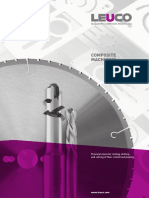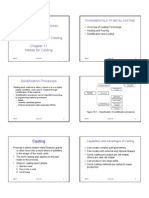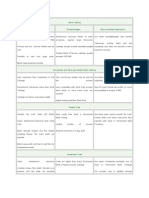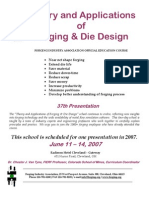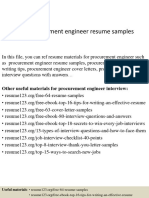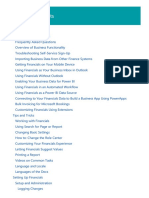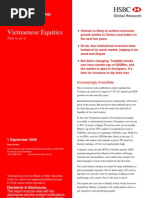Lesson 26 Basic Tools of Fitting and Sheet Metal Work, Sheet Metal Operations
Lesson 26 Basic Tools of Fitting and Sheet Metal Work, Sheet Metal Operations
Uploaded by
Subash NagaCopyright:
Available Formats
Lesson 26 Basic Tools of Fitting and Sheet Metal Work, Sheet Metal Operations
Lesson 26 Basic Tools of Fitting and Sheet Metal Work, Sheet Metal Operations
Uploaded by
Subash NagaOriginal Title
Copyright
Available Formats
Share this document
Did you find this document useful?
Is this content inappropriate?
Copyright:
Available Formats
Lesson 26 Basic Tools of Fitting and Sheet Metal Work, Sheet Metal Operations
Lesson 26 Basic Tools of Fitting and Sheet Metal Work, Sheet Metal Operations
Uploaded by
Subash NagaCopyright:
Available Formats
UNIT V
LESSON 26 FITTING AND SHEET METAL WORKING
BASIC TOOLS OF FITTING AND SHEET
METAL WORK, SHEET METAL
OPERATIONS
When you complete this module you will be able to Basic Information
MANUFACTURING PROCESS
1. Describe the fitting and sheet metal working process. Sheet metal forming is a grouping of many complementary
processes that are used to form sheet metal parts. One or more
2. Describe the materials used in sheet forming.
of these processes is used to take a flat sheet of ductile metal,
3. Describe the mechanical properties of metals. and mechanically apply deformation forces that alter the shape
4. Describe the metal’s behavior in sheet forming. of the material. Before deciding on the process (es), one should
5. Describe the drawing and bending process. determine whether a particular sheet metal can be formed into
the desired shape without failure.
6. Describe the shearing, sawing, grinding, punching, and
blanking process. Compared to casting and forging, sheet-metal parts offer the
advantages of lightweight and versatile shape.
7. Describe the dies, punch and types of dies.
Process Characteristics
• long parts with constant complex cross-sections;
• good surface finish;
Roll forming • high production rates;
• high tooling costs.
• large parts with shallow contours;
• suitable for low-quantity production;
Stretch forming • high labor costs;
• tooling and equipment costs.
• shallow or deep parts with relatively simple shapes;
• high production rates;
Drawing
• high tooling and equipment costs.
• includes a variety of operations, such as punching,
embossing, bending, flanging, and coining;
• simple or complex shapes formed at high production rates;
Stamping
• tooling and equipment costs can be high, but labor cost is
low.
• drawing and embossing of simple or complex shapes;
• sheet surface protected by rubber membranes;
Rubber forming • flexibility of operation;
• low tooling costs.
• small or large axisymmetric parts;
• good surface finish; low tooling costs, but labor costs can be
Spinning
high unless operations are automated.
• complex shapes, fine detail and close tolerances;
Superplastic • forming times are long, hence production rates are low;
forming • parts not suitable for high-temperature use.
• shallow contours on large sheets;
© Copy Right: Rai University
134 4A.182
•
MANUFACTURING PROCESS
shallow contours on large sheets;
• flexibility of operation;
Peen forming • equipment costs can be high;
• process is also used for straightening parts.
• very large sheets with relatively complex shapes, although
usually axisymmetric;
Explosive • low tooling costs, but high labor cost;
forming • suitable for low-quantity production;
• long cycle times.
• shallow forming, bulging, and embossing operations on
Magnetic-pulse relatively low-strength sheets;
forming • most suitable for tubular shapes;
• high production rates;
Basic tools of fitting and sheet metal work. Analysis of • what are the material properties which enter into
forming process like cup / deep drawing and bending. determining the characteristics of the formed part?
What Is A Sheet Metal Working? • how much force is required to shear the blank?
Sheet Metal Workers are part of the building and construction • how much deformation can be imposed on the blank
trades. In shops, we layout, fabricate and assemble sheet metal when it is being formed? for example, the amount of
products to be installed in buildings and construction projects. deformation in the bending process in the animation, or, the
The primary work is heating, ventilating and air conditioning. amount of deformation which can be imposed in forming the other
We also fabricate and install metal roofs, kitchen equipment, part which is needed to produce the ...
blowpipe systems, conveyors, chutes and hoppers.
• how much should the blank be over-bent to compensate
for springback?
Sheet Metal Materials
Intent The intent of this presentation is to describe material
properties which are useful in
• choosing metals for formed parts
• specifying material properties which determine forming
process and part performance
• developing and using quantitative process models
Introduction
Sheet metals are characterized by a high ratio of surface area to
thickness. A sheet thicker than 6mm (1/4 in) is generally called a
plate. Sheet forming usually involves relativly thin materials.
The deformation imposed in sheet metal forming is usually
bending and/or stretching.
The intent of this tutorial is to explain some of the engineering The products made by sheet-forming processes include a large
science concepts and analysis procedures used in describing and variety of shapes and sizes, ranging from simple bends to
mechanically modeling sheet metal forming processes. Concepts double curvatures with shallow or deep recesses. Typical
useful for describing the deformation imposed on the workpiece examples are metal desks, appliance bodies, aircraft panels,
or blank are emphasized. For example, we will try to answer beverage cans, auto bodies, and kitchen utensils.
questions such as: In typical sheet metal forming operations primary deformation
• which materials can be used to make formed parts? imposed is tensile. The major devices used are presses and dies.
• what are the material characteristics that make it useful for There are three basic types of operations in sheet metal forming
forming operations? processes: shearing, bending and drawing. The shape and
• what are the properties of materials which determine if the dimensions of the parts obtained correspond fairly well to
material will be useful for making a spring? if you haven’t those of the active elements of the pressing device, for example,
guessed what the part is in the part in the animation, this is a hint the punch shape is reproduced on the blank. There are differ-
© Copy Right: Rai University
4A.182 135
ences in shape due to material springback when the part is Steels are available in 1/4 hard, 1/2 hard and full hard condi-
MANUFACTURING PROCESS
removed from the punch-die and to other less drastic effects. tions.
Compared to other manufacturing processes (e.g., casting, Spring Steel has a high “elasticity,” that is, a large amount
forging and machining), forming has several technical-economic deformation can be imposed before the material takes on a
advantages: permanent set or plastic deformation is produced. These ideas
• Parts may be formed whose complex shapes are difficult or are covered in detail below.
even impossible to obtain by other techniques; Stainless Steels contain alloying additions of nickel and
• In most instances formed parts do not require additional chromium. Their cost is high,but because of their fine surface
mechanical processing; appearance and resistance to corrosion, they are used in forming
special parts. Stainless steels with various heat treating tempers
• The dimensional accuracy of parts ensures their
are commonly available.
exchangeability in assembly, the exception is the change in
sheet thickness on transition section where thinning is Copper and Copper Alloys
likely to occur; Copper and copper alloys are generally used for sheet forming
• Strain hardening increases the mechanical properties of where the advantages of their special properties justify their
formed parts; higher cost. The ductility of copper and its alloys reduces
cracking and wrinkling problems compared to other metals.
• Formed parts can be very light because complex shapes
Also, copper has unique advantages in high electrical and
including strengthening features such as ribs can be
thermal conductivities. It is used in forming radiator grids to
produced;
dissipate auto engine heat, and in electrical switches, relays, etc.
• Presses allow high production rates by fast operation and Copper alloys usually have excellent corrosion resistance. They
the use of sequential forming steps. are costly and have low strength.
Materials Commonly Used in Sheet Forming Soft Copper is relatively pure copper and is soft and easily
There are many materials, which can be formed. We will deformed. Mechanical processing, such as rolling to produce
concentrate here on only the most commonly used ones. The sheet, alters material strength. Annealing can produce different
intent is to present an overview of material types and the tempers. Processes needed to produce sheet stock, which is then
material properties that make the materials amenable to further processed, can have large effects on material properties.
forming. For each material type or class of material there are This is an important issue and is discussed further along in this
large numbers of alloys and heat treatments which effect tutorial.
material properties and “formability.” Cartridge Brass is 70% Cu, 30% Zn and in its soft temper
Steel, copper, aluminum and their alloys are most frequently state is very ductile. Its name suggests the possibiliy of large
used materials for formed parts. Which metal is chosen for a deformation as in the drawing (in which a punch pulls or draws
particular application depends on the requirements of the part, material into a die) of cartridges. Other uses may call for
the cost of manufacturing it, and the availability of the metal. stronger material and so 1/4 hard, 1/2 hard and spring tempers
Requirements of parts vary. The primary consideration for one are available.
part may be strength; for another it may be surface appearance. Phosphor Bronze with a composition of 95% Cu and 5% Sn
Steel is commonly available in a spring temper. The increased harness
Steel is composed primarily of iron with carbon as the major and “elasticity” of this material makes it suitable for parts which
alloying element. The greater the percentage of carbon, the must remain elastic, e.g., springs and electrical contacts. Further
stronger and stiffer the steel. High-carbon steels are generally tailoring of this material results in the “extra spring temper” of
infeasible for use as workpiece materials in sheet metal forming 92% Cu 8% Sn phosphor bronze used in snap over switches.
because of their high resistance to permanent or plastic Leaded Brass such as 65% Cu, 33% Zn, 2% Pb “clock brass” is
deformation. Most automotive stampings are produced from soft and easily worked. Such soft materials are used in applica-
low-carbon steel, containing less than .15% carbon. In some tions such as architectural decorations which do not require great
applications resistence to plastic deformation is desired, e.g., in part strength but rather a material which can be formed into
springs. intricate shapes.
Cold Rolled Steel Naval Brass is a composition near 60% Cu, 40% Zn, rather
As with most metals the alloy composition, heat treatment and than officers. Corrosion resistance makes it useful in marine
any mechanical processing (rolling in this case) are all important (ocean not branch of service) applications.
in determining material behavior. The “drawing quality” steels Beryllium Copper provides a wide range of mechanical
are processed to produce uniform deformation up to large properties since many alloys and tempers are available.
deformations (deformation and uniform deformation is
discussed in detail below). One such deformation behavior Aluminum
improving process is used in “aluminum killed” steel. Alumi- Aluminum has achieved importance in virtually all segments of
num is used to remove oxygen from the steel and so minimize the world economy, its principal uses are in transportation,
the deleterious effects of oxygen on the extent of deformation construction, electrical applications, beverage cans, cooking
which can be imposed and on the uniformity of deformation. utensils and mechanical equipment. A number of unique and
© Copy Right: Rai University
136 4A.182
attractive properties account for the engineering significance of
MANUFACTURING PROCESS
Notes:
aluminum: formability, light weight, corrosion resistance, and
good electrical and thermal conductivity. Aluminum has a
specific gravity about one third that of steel. The many alloys
and heat treatments available provide material with a very broad
range of mechanical properties.
1100-O Aluminum is the “dead soft” temper of this alloy.
1100-H14 has higher strength due to the heat treatment but is
still soft and easy to form.
2024-O Aluminum is an alloy designed to have higher
strength. In its heat treated
2024-T3 form it is extensively used for aircraft components.
3003-O Aluminum is an alloy which when heat treated
properly, e.g.,
3003-H14 has good “workability” or is “formable” and so finds
use in cooking utelsils and building siding.
5000 series Aluminums posess good corrosion resistence and
can be easily welded. An alloy such as
5052-H34 which has limited cold-workabiliy finds use where
the extent of deformation imposed in forming large curvature
panels is small, e.g., boat hulls.
6061-O Aluminum is the not heat treated version of a widely
used series of aluminums can have excellent strength. 6061-T6
is used in many machined parts since its mechanical properties
are such that it is strong and also is easily machined in the sense
of good surface finish.
7075-O Aluminum is the soft state of the
7000 series aluminum alloys which have very high stengths and
find their way into many airframe structures and highly stressed
parts.
The most serious drawback of aluminum from an engineering
viewpoint is its relatively low modulus of elasticity, roughly one
third of that of steel. Aluminum alloys have much higher
strength than pure aluminum yet retain the advantages of light
weight, good thermal conductivity and corrosion resistance. But
their thermal conductivity is lower than pure aluminum.
Question: What material can be used to form the spring
element in a clamp type paper clip? What material can be used
for the tuna can and can top?
• a. Iron, Aluminum
• b. Aluminum, Lead
• c. Steel, Aluminum
• d. Copper, Lead
• e. Nickel, Copper alloy
Question: The typical aluminum beverage can has a lid made
out of a different aluminum alloy than the can body. Why is
this so?
• a. Use less expensive material for top
• b. Need added strength in lid
• c. Make can easier to recycle
• d. Different processes are used to make these two parts
© Copy Right: Rai University
4A.182 137
You might also like
- Case Study Toyota in ChinaDocument2 pagesCase Study Toyota in ChinaSubash Naga0% (2)
- Guide To Casting and Molding Processes-1Document7 pagesGuide To Casting and Molding Processes-1Joao LuisNo ratings yet
- Sheet-Metal Forming Processes: Haipan SalamDocument86 pagesSheet-Metal Forming Processes: Haipan Salamprasetyokolik-1No ratings yet
- 18arc82 - Materials and Methods in Building Construction Viii Viii Semester C SectionDocument73 pages18arc82 - Materials and Methods in Building Construction Viii Viii Semester C SectionSAI BHAVANA AKURATINo ratings yet
- Fundamentals of Manufacturing Processes: Manufacturing Process Specific Advantages and LimitationsDocument7 pagesFundamentals of Manufacturing Processes: Manufacturing Process Specific Advantages and Limitationsalagar krishna kumarNo ratings yet
- Manufacturing Processes and Technology (Mem360) 2Document13 pagesManufacturing Processes and Technology (Mem360) 2Azhar HafiqNo ratings yet
- Casting Methods Pros and Cons Cheat Sheet 2Document1 pageCasting Methods Pros and Cons Cheat Sheet 2calderon.hilaNo ratings yet
- Explaining and Assessing Manufacturing TechniquesDocument45 pagesExplaining and Assessing Manufacturing Techniquesothmane elkramiNo ratings yet
- Buehler Surface Coatings Webinar July 2020Document59 pagesBuehler Surface Coatings Webinar July 2020Carolina García DíazNo ratings yet
- Low Pressure Casting PrinciplesDocument21 pagesLow Pressure Casting PrinciplesTalha AkınNo ratings yet
- 1 - Writeup On Science of Metal Cutting With Dynamometer-1Document29 pages1 - Writeup On Science of Metal Cutting With Dynamometer-1HARSH KUMAR MEENANo ratings yet
- Manufacturing Processes II: Fundamentals of Metal FormingDocument17 pagesManufacturing Processes II: Fundamentals of Metal FormingMohamed Galal MekawyNo ratings yet
- Rapid PrototypingDocument23 pagesRapid PrototypingRAIHAN SHAIKHNo ratings yet
- Turning Process, Defects, EquipmentDocument7 pagesTurning Process, Defects, Equipmentvinaybaba100% (1)
- Process Design in Impression Die ForgingDocument12 pagesProcess Design in Impression Die Forgingmike vidalNo ratings yet
- Afdex Tut 1Document28 pagesAfdex Tut 1panyamnrNo ratings yet
- Composite MachiningDocument24 pagesComposite Machiningdr.alimthnegmnNo ratings yet
- Advantages: Layer by Layer Fabrication Directly A Kind of Manufacturing Process (Or)Document7 pagesAdvantages: Layer by Layer Fabrication Directly A Kind of Manufacturing Process (Or)Li LuNo ratings yet
- State of The Art of MicromachiningDocument15 pagesState of The Art of MicromachiningSandeep SinghNo ratings yet
- This PDF Document Is A Partial Sample Chapter From The Book..Document9 pagesThis PDF Document Is A Partial Sample Chapter From The Book..Anonymous VRspXsmNo ratings yet
- FORMWORK FinalDocument34 pagesFORMWORK FinalVala Vraj M.No ratings yet
- Module 5 Design of Components With Forging ConsiderationDocument34 pagesModule 5 Design of Components With Forging ConsiderationMaheshNo ratings yet
- Exp1 LatheDocument6 pagesExp1 Latheawantika.officialNo ratings yet
- Advanced Mrtods of MachiningDocument16 pagesAdvanced Mrtods of MachiningMojtaba MoradiNo ratings yet
- Be Mat Vat DucDocument21 pagesBe Mat Vat DucTrung Nguyễn NgọcNo ratings yet
- Think Productivity, Think HSS: BroachingDocument31 pagesThink Productivity, Think HSS: BroachingSangram Kharade IINo ratings yet
- Machining Lecture 1Document25 pagesMachining Lecture 1ShambhavamNo ratings yet
- Module 6 Post ProcessingDocument30 pagesModule 6 Post ProcessingSanthosh Reddy SankarreddyNo ratings yet
- Machine Tools Cutting Tool ClassificationDocument6 pagesMachine Tools Cutting Tool Classificationhigabac297No ratings yet
- IE Workholding DevicesDocument9 pagesIE Workholding DevicesFaith GoNo ratings yet
- Afdex Tut 3Document33 pagesAfdex Tut 3panyamnrNo ratings yet
- Fixture: - Location - Clamping - Tool Setting Block - TenonDocument35 pagesFixture: - Location - Clamping - Tool Setting Block - TenonChen WANYING100% (1)
- Hot Chamber Die Casting ProcessDocument1 pageHot Chamber Die Casting ProcessNordiana IdrisNo ratings yet
- Welding-RobotsDocument11 pagesWelding-Robotsಪವರ್ ಆನಂದ್No ratings yet
- 08 Casting - ForgingDocument35 pages08 Casting - ForgingomkardashetwarNo ratings yet
- Ingrid Enid Vera Paniagua-ManufacturaDocument4 pagesIngrid Enid Vera Paniagua-ManufacturaIngrid PaniaguaNo ratings yet
- Design and Simulation of Different Progressive ToolsDocument8 pagesDesign and Simulation of Different Progressive ToolsAnnaNo ratings yet
- Sheet Metal Forming Process Chapter 7Document155 pagesSheet Metal Forming Process Chapter 7Arun Pravin APNo ratings yet
- Designing For Sheet Metal Xometry EbookDocument25 pagesDesigning For Sheet Metal Xometry EbookRodolfoNo ratings yet
- Manufacturing technology Module 1 easy notesDocument5 pagesManufacturing technology Module 1 easy notesManuNo ratings yet
- Introduction To Microcasting Techniques For MicroManufacturingDocument41 pagesIntroduction To Microcasting Techniques For MicroManufacturingALDO ROGERNo ratings yet
- Ame - Met 306 - M 1Document129 pagesAme - Met 306 - M 1AKSHAY S PAINo ratings yet
- Group 1 - Solidification Processes & Particulate ProcessingDocument6 pagesGroup 1 - Solidification Processes & Particulate ProcessingRoberto L. Casas Jr.No ratings yet
- CastingDocument4 pagesCastingVighnesh AmbetkarNo ratings yet
- Class 1Document13 pagesClass 1sanukumar2382No ratings yet
- Cutting Tools: IME 211 Workshop TechnologyDocument10 pagesCutting Tools: IME 211 Workshop Technologymoha amroNo ratings yet
- Casting 3Document28 pagesCasting 3Hoza EssamNo ratings yet
- Chap04-04 Important Issues Slicing and SupportDocument21 pagesChap04-04 Important Issues Slicing and Supportharshads1502No ratings yet
- DIANA BrochureDocument7 pagesDIANA BrochureMohamad HartadiNo ratings yet
- MPP Short NoteDocument22 pagesMPP Short NoteAsif BNo ratings yet
- Metal Casting ProcessesDocument3 pagesMetal Casting Processesshreyrana1011No ratings yet
- Die Design ProgramDocument5 pagesDie Design ProgramSundar KaruppiahNo ratings yet
- Sheet Lamination Processes: This ChapterDocument8 pagesSheet Lamination Processes: This ChapterHarsh BansalNo ratings yet
- Ceramic Slurry - An Overview - ScienceDirect TopicsDocument16 pagesCeramic Slurry - An Overview - ScienceDirect TopicsMusteizerNo ratings yet
- BT4 Forming-C7 ManufacturingDocument4 pagesBT4 Forming-C7 Manufacturing22026155No ratings yet
- Unit 2Document1 pageUnit 2AshirwadNo ratings yet
- AME Module 5Document16 pagesAME Module 5AKSHAY S PAINo ratings yet
- Unit 3 Manufacturing ProcessesDocument92 pagesUnit 3 Manufacturing Processesusama riazNo ratings yet
- Manufacturing Technology (MEC - 205) : Unit - 1 Introduction To Manufacturing and Metal CastingDocument74 pagesManufacturing Technology (MEC - 205) : Unit - 1 Introduction To Manufacturing and Metal CastingShridhar SavatNo ratings yet
- Sheet Production TechnologyDocument23 pagesSheet Production TechnologyOmar AlyNo ratings yet
- Learn Critical Aspects of Pattern and Mould Making in FoundryFrom EverandLearn Critical Aspects of Pattern and Mould Making in FoundryNo ratings yet
- Material Planning AnalystDocument1 pageMaterial Planning AnalystSubash NagaNo ratings yet
- Chennai RentReceiptDocument1 pageChennai RentReceiptSubash NagaNo ratings yet
- Years of Experience To Work OnDocument1 pageYears of Experience To Work OnSubash NagaNo ratings yet
- Lecture 11 Gas Flow MeasurementDocument29 pagesLecture 11 Gas Flow MeasurementSubash Naga0% (1)
- Concept Question 1 Concept Question 1: ENGR3350 Spring 2007 ENGR3350 Spring 2007Document3 pagesConcept Question 1 Concept Question 1: ENGR3350 Spring 2007 ENGR3350 Spring 2007Subash NagaNo ratings yet
- B31.1 - 2012 - Power Piping: American Society of Mechanical Engineers - Asme AnsiDocument3 pagesB31.1 - 2012 - Power Piping: American Society of Mechanical Engineers - Asme AnsiSubash NagaNo ratings yet
- Torque Value - With MetricDocument2 pagesTorque Value - With MetricSubash NagaNo ratings yet
- Read MeDocument1 pageRead MeSubash NagaNo ratings yet
- SampleDocument16 pagesSampleSubash NagaNo ratings yet
- Acoustic Emission Method - Short Presentation For StudentsDocument45 pagesAcoustic Emission Method - Short Presentation For StudentsSubash Naga100% (2)
- To-Do List-Subash Sandar N: Schedule Description Due DateDocument4 pagesTo-Do List-Subash Sandar N: Schedule Description Due DateSubash NagaNo ratings yet
- Dynamics365for Financials PDFDocument813 pagesDynamics365for Financials PDFKakumanu Siva100% (1)
- Parts Catalog: 0CR10-M47602ENDocument85 pagesParts Catalog: 0CR10-M47602ENEfrain FlorezNo ratings yet
- Post-Show-Report-WINDERGY-2023 (1)Document10 pagesPost-Show-Report-WINDERGY-2023 (1)akshayNo ratings yet
- Global Consumerism and Climate ChangeDocument5 pagesGlobal Consumerism and Climate ChangeReine CampbellNo ratings yet
- AMOS Mail Admin GuideDocument78 pagesAMOS Mail Admin GuideDarylNo ratings yet
- Assessment of Vat Administration (A Case Study On Bishoftu Town)Document41 pagesAssessment of Vat Administration (A Case Study On Bishoftu Town)chalachew mekonnenNo ratings yet
- A264 MsdsDocument11 pagesA264 Msdsjangri1098No ratings yet
- Vietnamese Equities - HSBC ReviewDocument26 pagesVietnamese Equities - HSBC Reviewapi-3706396No ratings yet
- Sample CISSP ResumeDocument4 pagesSample CISSP ResumeAskia MappNo ratings yet
- Cirrus PFD Pilots GuideDocument42 pagesCirrus PFD Pilots GuidehoangautNo ratings yet
- Advanced Photoshop Issue 017 PDFDocument83 pagesAdvanced Photoshop Issue 017 PDFDipesh BardoliaNo ratings yet
- Swetha Resume DocDocument2 pagesSwetha Resume Docswathy.kNo ratings yet
- Instruction manual ECSS18AB ECSS23AB TOUCHDocument41 pagesInstruction manual ECSS18AB ECSS23AB TOUCHRohelith HidalgoNo ratings yet
- TR Technology Radar Vol 27 enDocument43 pagesTR Technology Radar Vol 27 enstart-up.roNo ratings yet
- Memorial On Behalf of PetitionerDocument22 pagesMemorial On Behalf of PetitionerKoshalNo ratings yet
- 0807 - Ec 1Document23 pages0807 - Ec 1haryhunter50% (2)
- Weekly AssignmentDocument66 pagesWeekly AssignmentThanaboon SalakruthaiNo ratings yet
- Peninsula - Master F1 2023 and F2 2024 Website VersionDocument7 pagesPeninsula - Master F1 2023 and F2 2024 Website Versionarimasen88No ratings yet
- Projectproposalon 10 MwsolarpvpowerplantDocument41 pagesProjectproposalon 10 MwsolarpvpowerplantNaveenNo ratings yet
- Answer Key - Limitation Act - Raj JLODocument6 pagesAnswer Key - Limitation Act - Raj JLOMayank SainiNo ratings yet
- 10 Methods For Identifying Customer Needs-1Document6 pages10 Methods For Identifying Customer Needs-1EJ VillanuevaNo ratings yet
- CORRECTED SOL. MAN. - CHAPTER 15 - ACCOUNTING FOR CORPORATIONS PROB 2-3 CompleteDocument8 pagesCORRECTED SOL. MAN. - CHAPTER 15 - ACCOUNTING FOR CORPORATIONS PROB 2-3 Completeruth san joseNo ratings yet
- Statistics Page 27Document10 pagesStatistics Page 27BhodzaNo ratings yet
- Clinical PharmacyDocument38 pagesClinical PharmacyJurusan Farmasi Poltekkes MedanNo ratings yet
- Accounting For Business CombinationsDocument10 pagesAccounting For Business CombinationsChennie Mae Pionan SorianoNo ratings yet
- HTM 67Document31 pagesHTM 67Sundar DAACNo ratings yet
- Sandejas Vs RoblesDocument5 pagesSandejas Vs RoblesMaxxNo ratings yet
- Rimando Vs Sps. Aldaba and PeopleDocument3 pagesRimando Vs Sps. Aldaba and PeoplePinky de GuiaNo ratings yet
- English AppendixDocument20 pagesEnglish AppendixGaurav SrivastavaNo ratings yet
- Accu TunerDocument5 pagesAccu TunerDavid DowdNo ratings yet
















